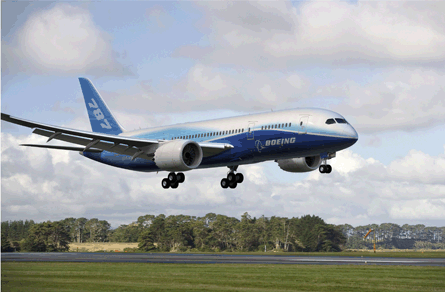Boeing has revealed the first details of a fast-paced, around-the-clock 787 operation. The programme is set to launch by 1 July and will test and certificate the 787-8 in less than nine months.
The airframer, which has provided the first detailed update on the Dreamliner's progress for nine months, says its schedule includes a 15-20% reserve to deal with the kind of unplanned contingencies for which flight-test programmes are famous, and, indeed, necessary.
The nine-month plan is aggressive by any standard, but is stretched by two months compared with Boeing's original flight-test schedule. Boeing decided to build in extra margin for error when the programme was rebaselined in April 2008.
"The end result is we have to expect that something isn't going to go the way we expect it to go," says Frank Rasor, Boeing's director of flight-test operations. "I kind of look at it as that's job security for me."
 |
|---|
© Boeing |
Although preliminary structural and systems tests "have gone reasonably well", says Rasor, the combined 6,800h of scheduled flight and ground tests is likely to reveal quirks about the aircraft its designers never imagined.
Flight-test engineers have already become concerned about the difficulty of running simulated tests with the 787's highly integrated avionics and flight controls. During tests on the ground, engineers often simulate an airborne event by inserting a "bit" into the relevant software system.
But with the 787's interactive network, "you need all of the boxes and components that may be talking to either believe it's in the air mode or in the ground mode" says Rasor. "It isn't as easy to trick it and make it think it's flying when it's really on the ground."
The first-flight date remains set for the second quarter. A series of production system breakdowns, design changes and a labour strike since August 2007 has kept the event on hold.
The most significant design change Boeing has revealed since March 2008 involved strengthening the centre wing box.
More recently, however, Boeing has identified a problem with the design of parts inside the wing called "stringer run-outs", which serve to transfer loads where the stringers terminate.
"What we found was that they weren't as soft as we wanted them and they weren't taking the load out as gracefully as we wanted on them," says Mike Delaney, Boeing vice-president and chief project engineer. "We're in the process of correcting that or making a design change."
Delaney says the run-out problem appeared only in structural tests beyond the so-called ultimate load, or 50% more than the maximum load expected to be encountered during flight.
"The margins aren't where we wanted them so we corrected that stringer run-out," he says. Dealing with such issues complicates the workflow for suppliers, he adds, but falls short of a "catastrophic" event that would have a major impact on the flight-test programme.
Boeing has set up a 24h, seven-day-a-week flight-test operation to accommodate the 787 flight-test programme's schedule. On a typical day, a flight-test aircraft will be available for about 8h of either flight tests or ground tests, with the balance of 16h set aside for maintenance. Nearly all of the flight tests will be conducted in daylight hours, except for a few test events that specifically call for night flying, says Rasor.
Each of the six aircraft in the flight-test programme has been assigned a specific role.
As the first aircraft in flight, the 787 identified as ZA001 will be used to check flutter and validate the basic flying envelope. ZA002 is expected to join the flight-test fleet within three weeks of the first flight, so will be used in conjunction with ZA001 for stability and control tests.
The first four flight-test aircraft will be powered by the Rolls-Royce Trent 1000. An improved version that Boeing calls "package B" will be installed on ZA004 about six months after the flight-test phase begins. ZA004 will also be instrumented for the flight loads survey, in which Boeing verifies that loads on each section of the aircraft match pre-flight estimates.
Boeing has assigned most of the interior systems tests to ZA003. This aircraft will also be used to fly to launch operators ANA and Japan Airlines for route-proving and extended twin-engine operations (ETOPS) qualification.
For ETOPS performance, Boeing is seeking to offer 333min clearance at entry into service, with 207min as a back-up.
Source: Flight International
















